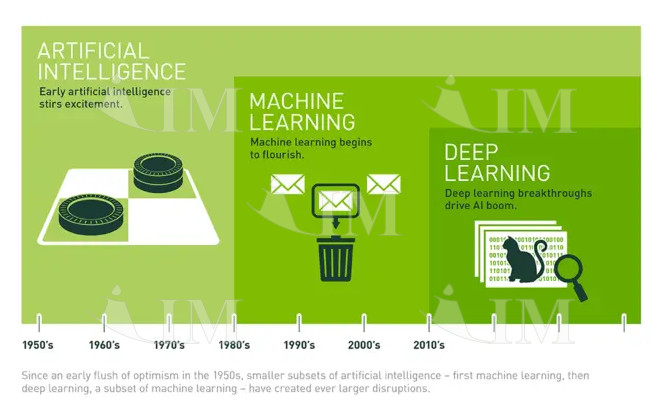人工智能,机器学习和深度学习之间有什么区别?
时间:2016-08-01 来源:Nvidia 点击:
次
这是一个由多个部分组成的系列文章的第一篇,该系列文章介绍了长期的技术记者迈克尔·科普兰德(Michael Copeland)的深度学习基础。
|
人工智能,机器学习和深度学习之间有什么区别?
Artificial intelligence is the future. Artificial intelligence is science fiction. Artificial intelligence is already part of our everyday lives. All those statements are true, it just depends on what flavor of AI you are referring to.
For example, when Google DeepMind’s AlphaGo program defeated South Korean Master Lee Se-dol in the board game Go earlier this year, the terms AI, machine learning, and deep learning were used in the media to describe how DeepMind won. And all three are part of the reason why AlphaGo trounced Lee Se-Dol. But they are not the same things.
The easiest way to think of their relationship is to visualize them as concentric circles with AI — the idea that came first — the largest, then machine learning — which blossomed later, and finally deep learning — which is driving today’s AI explosion — fitting inside both.
From Bust to Boom
AI has been part of our imaginations and simmering in research labs since a handful of computer scientists rallied around the term at the Dartmouth Conferences in 1956 and birthed the field of AI. In the decades since, AI has alternately been heralded as the key to our civilization’s brightest future, and tossed on technology’s trash heap as a harebrained notion of over-reaching propellerheads. Frankly, until 2012, it was a bit of both.
Over the past few years AI has exploded, and especially since 2015. Much of that has to do with the wide availability of GPUs that make parallel processing ever faster, cheaper, and more powerful. It also has to do with the simultaneous one-two punch of practically infinite storage and a flood of data of every stripe (that whole Big Data movement) – images, text, transactions, mapping data, you name it.
Let’s walk through how computer scientists have moved from something of a bust — until 2012 — to a boom that has unleashed applications used by hundreds of millions of people every day.

Artificial Intelligence — Human Intelligence Exhibited by Machines
Back in that summer of ’56 conference the dream of those AI pioneers was to construct complex machines — enabled by emerging computers — that possessed the same characteristics of human intelligence. This is the concept we think of as “General AI” — fabulous machines that have all our senses (maybe even more), all our reason, and think just like we do. You’ve seen these machines endlessly in movies as friend — C-3PO — and foe — The Terminator. General AI machines have remained in the movies and science fiction novels for good reason; we can’t pull it off, at least not yet.
What we can do falls into the concept of “Narrow AI.” Technologies that are able to perform specific tasks as well as, or better than, we humans can. Examples of narrow AI are things such as image classification on a service like Pinterest and face recognition on Facebook.
Those are examples of Narrow AI in practice. These technologies exhibit some facets of human intelligence. But how? Where does that intelligence come from? That get us to the next circle, machine learning.
|
相关文章
- 机器学习产业Longlist长名单(TOP44) 机器学习 人工智能 标杆企业
- 全球及中国机器学习行业发展研究报告(2024-2030年版) 机器学习 人工智能 机器学习报告
- 《全球机器学习行业技术及市场前景展望报告》(全球技术及市场版) 机器学习 人工智能 机器学习报告
- Oracle:什么是机器学习? 机器学习 人工智能 深度学习
- AI,机器学习和深度学习之间有什么区别? AI 机器学习 深度学习
- 五部门关于公布智能网联汽车“车路云一体化”应用试点城市名单的通知 车路云
- 国家人工智能产业综合标准化体系建设指南 (2024版)全文及下载 人工智能 AI 政策 产业政策
- IIM信息:全球及中国机器视觉行业研究报告(2024) 机器视觉 机器视觉报告
- AUTO TECH 2025 华南展——第十二届广州国际汽车技术展览会 汽车电子 智能汽车
- 汇聚创新,以“视觉”致远——VisionChina2024(上海)机器视觉展圆满闭幕,共绘 机器视觉 展会论坛
- 电池管理系统(BMS)市场调查与技术发展趋势报告(2024) BMS 电池管理系统 BMS报告 电池管理系统报告 研究报告
- 中国机器视觉行业技术标准 机器视觉 政策 技术政策 技术标准
- 2016-2030年全球机器视觉行业市场规模及预测 机器视觉 数据 大数据
- 2022-2030年全球机器视觉应用领域市场规模及数据预测 机器视觉 数据 大数据
- 2022-2030年全球机器视觉应用领域市场规模及数据预测 机器视觉 数据 大数据
- 全球机器视觉产业链竞争情况 机器视觉 数据 大数据
- 中国智能制造主要环节机器视觉应用场景 智能制造 机器视觉
- 2016-2030年中国机器视觉行业生命周期 机器视觉 数据 大数据
- 2016-2030年中国机器视觉行业市场规模及预测 机器视觉 数据 大数据
- IIM信息:全球及中国机器视觉行业分析 机器视觉 机器视觉报告 研究报告
- 中国机器视觉领域企业竞争格局 机器视觉 标杆企业
- 2021-2023年中国机器视觉行业市场占有率及集中度 机器视觉 标杆企业
- 2020-2023年中国机器视觉行业重点企业海内外业务占比 机器视觉 标杆企业
- 中国机器视觉重点企业技术领域与重点技术 机器视觉 标杆企业
- 第104届中国电子展 电子元器件 集成电路 电子 物联网 展会论坛
- 全球手机市场及中国品牌出海市场营销研究报告(2024Q2) 手机 研究报告 手机报告
- 第七届全球电子技术(重庆)展览会 传感器 机器人 智能制造 智慧工厂 工业自动化 展会论坛
- IIM信息发布《全球手机市场及中国品牌出海市场营销研究报告(2024Q2)》 手机 研究报告 手机报告
- 工业和信息化部 国家标准化管理委员会关于印发物联网标准体系建设指南(2 物联网 政策 产业政策 技术政策
- 《物联网标准体系建设指南(2024版)》一图读懂 物联网 政策 产业政策 技术政策
- 工业机器人行业规范条件(2024版)工业机器人行业规范条件管理实施办法(2 工业机器人 机器人 政策 产业政策 技术政策
- 强制性国家标准GB 44497-2024《智能网联汽车 自动驾驶数据记录系统》 智能网联汽车 车联网 自动驾驶 政策 产业政策 技术政策 技术标准
- 工信部:强制性国家标准GB 44495-2024《汽车整车信息安全技术要求》 信息安全 政策 技术政策 技术标准
- 强制性国家标准GB 44496-2024《汽车软件升级通用技术要求》 汽车软件 政策 技术政策 技术标准 车联网 智能汽车 智能网联汽车
- 关于推动新型信息基础设施协调发展有关事项的通知(工信部联通信〔2024〕1 新型信息基础设施 智算中心 超算中心 边缘数据中心 政策 产业政策
















 京公网安备 11010602104466号
京公网安备 11010602104466号